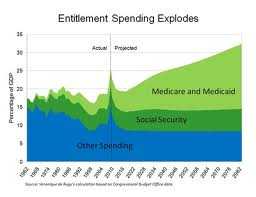
Ever wonder what they are talking about in Washington D.C.? Fiscal cliff, sequester, supercommittee? Well, much of the public debate about the growing national debt has centered around Medicare. It sounds hard to understand, but it is relatively easy to understand once you grapple with its inevitable collapse just 11 years from today.
Medicare, a popular healthcare program for older Americans, was first introduced in 1965 by President Lyndon Johnson. According to yahoofinance.com, 80 million Americans use this program and are funded by a “primary trust fund” that is expected to be insolvent by 2024. For starters, according to www.Budget.House.gov, annual healthcare spending per household is 50 times higher than it was in 1965. Thus, healthcare spending is consuming approximately one fifth of our entire economy as opposed to 5% of our economy in 1965. This program is modeled based upon a “fee for service”.
This “fee for service” system has many structural deficiencies that are waiting to implode. Thus, not only are there problems with it’s out of control expansion, but structural problems that require a lot of political courage in order to solve. Therefore, let’s adopt a plan similiar to the one being floated by Republican Congressman Paul Ryan. In his plan, a Path to Prosperity, he recommends many solutions. For example, in the current system, if a Medicare patient goes to the doctor, they receive health care services. Then the doctor sends the bill for their medical visit to Medicare. Medicare then reimburses the doctor through borrowed money. Thus, the patient is disconnected from the cost. The patient pays premiums for Medicare every month, but has no incentive to demand the best care if Medicare ultimately picks up the tab. This increases the probability of unnecessary medical procedures and allows a patient to be separated from the true cost. When someone directly pays for something, they tend to take greater care of that product. In healthcare, though, that does not happen.
Therefore, Medicare should institute a “premium support model”, which allows consumers to choose from a guaranteed list of health plans. This plan would increase competition amongst health care providers, and would subsequently lower health premiums. This system would allow people to cherish the care that they are paying for, and would give them a greater incentive to demand the best quality.
Medicare should also promote means testing, which forces wealthy beneficiaries to pay for a greater share of the program. However, this change is minimal and should only be considered as part of a larger overhaul.
In conclusion, the “third rail” of American politics must be touched and reformed so that current retirees are not affected. However, for younger Americans changes must be made in order to ensure the solvency of the program for future generations. This is the most visible and obvious crisis this country faces. The only reason why we can’t tackle this problem is because of a lack of courage in Washington D.C. to make hard choices.



